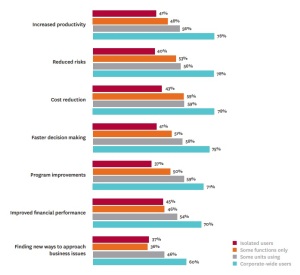What is it? How to use? Why is it important?
More and more companies are unlocking the key to interpreting their business data and understanding their enterprise like never before. Data-driven decision making is defined as “the practice of basing decisions on the analysis of data rather than purely on intuition.”
Data-driven decision making has a number of processes. These processes can be arranged into the following steps:
- Understand the real business question
- Identify the kind of data required to reach a conclusion
- Collect and gather the data
- Analyse, interpret and validate the data
- Make a decision or come to a conclusion
To begin with, the most important part of the process is the one where you need to understand the question. Once the question is in grip, looking for data can be simplified. For example, let the question be: What drives a high-performance sales team? Now, to come to a decision for this question, one will need specific data. Only way to have data is by gathering it through HR automation.
Data regarding each sales employee’s contribution and sales, their incentives and rewards, and much more when graphed will lead to formatted data that can then be studied to derive insight about the sales process.
Based on this conclusion one can then start thinking of what steps to take and what processes to modify. Reaching a decision based on the study of this kind of data is called data-driven decision making.
To understand the workforce of a company and how an organization really works, one needs to understand the people data of that company. Who will be our best leaders? How can we change behaviour to improve customer retention? Answers to such question will only come from intelligence collected from employee data.
Analysis regarding recruitment, compensation, engagement etc., can easily be chalked out from people data or HR management data. All this data together can be managed, clubbed and studied to understand how it relates to business outcomes.

Keeping data organized is an integral part of managing data. Reports such as leave report, headcount report, survey report, live employee report, attrition report, employee master information, etc., can be generated from organised data for better analysis and understanding.
“The evolution of decision-making” is a Harvard Business Review Analytic Service Report for the year 2012 which was compiled after a global survey of 646 executives, managers and professionals across all industries and geographies. In the report, the following data is depicted as an answer to the question: What benefits/positive impacts have organisations seen from the use of analytics?
Besides being very promising, it is important to also understand that data-driven decision making has its limitations. The timing of embedding decision into process needs to be chosen with care. Can the decision made on the data be used as a tool to make people more efficient? How can it be used technically for the advancement of the firm?
As organisations become critically dependent on employee competencies, how can HR Managers make data-driven decisions? If you have discovered small steps to start, you have embarked on the grand journey of making your organisation an efficient workplace that can boast of objectivity rather than subjectivity.

PeopleWorks, a simple and efficient Human Capital Management Solution designed to manage employee data through a centralized, secure platform on the cloud.
Call us for a Free Demo today! – +919916214888
